
Dr. John Bilezikian specializes in Endocrinology, Diabetes & Metabolism, with a special focus on Osteoporosis and Metabolic Bone Disorders. Dr. Bilezikian is a major national and international spokesperson for the field of metabolic bone diseases. His major research interests are related to the clinical investigation of metabolic bone diseases, particularly primary hyperparathyroidism and osteoporosis. In 2007, he initiated an Osteoporosis Diagnostic and Treatment Program at the Research Centre of Maternal and Child Health Protection in Yerevan, Armenia. This program included obtaining and installing a state-of-the-art bone densitometer and formal training of over 100 physicians.
Silberberg Professor of Medicine
Vice-Chair, International Education and Research
Vagelos College of Physicians and Surgeons
Columbia University, New York, NY
International Bone Women’s Health Armenia
Awarded:
$50,000 in 2024
$50,000 in 2023
Why The Foundation for Gender-Specific Medicine is supporting The Osteoporosis Center of Armenia
What is Osteoporosis?
Osteoporosis is one of the most important diseases of our time. It is a condition associated with reduced bone density (i.e., bone calcium) and a reduction in bone quality. This condition leads to an increased risk of fractures that are not due to traumatic events like an automobile accident. It is estimated that over 200 million individuals worldwide have osteoporosis. By 2050, there will be over 6 million fractures in the world on an annual basis. In the United States, it is estimated that over 10 million individuals have osteoporosis, and that an additional 42 million individuals have low bone density. Over 2 million fractures occur yearly because of osteoporosis. The lifetime risk in a 50-year-old Caucasian woman of sustaining an osteoporotic fracture is 50%. The estimated annual cost to care for individuals with osteoporosis and its complications is over 17 billion dollars divided into in-patient care (about 10 billion), long-term care (over 5 billion) and outpatient care (over 2 billion). In even starker terms, a hip fracture occurs in the world, on average, every 30 seconds. The incidence of a fracture due to osteoporosis is higher than the incidence of breast cancer. These points illustrate the pervasive and pernicious influence that this disease has on the health and longevity of the aging population.
Strengthening the Backbone of a Nation: 18 Years Advancing Women’s Bone Health in Armenia
I have been committed to improving the skeletal health of women in Armenia for the past 18 years. It was at that time that I was introduced, in person, to my ancestral homeland. That experience inspired me to understand, in that country, gaps in osteoporosis with regard to knowledge, epidemiology, and awareness. I also recognized at that time that Armenia had no bone densitometers, the state-of-the-art approach to making a diagnosis of osteoporosis. Additionally, health care providers had little knowledge about nutritional and therapeutic approaches to this pervasive disease. Over the 18-year period of time, we have made much progress in providing instrumentation to test women for osteoporosis, teaching doctors and other health care professions how to use bone densitometry, evaluate patients, and administer treatment. We have regularly conducted seminars in osteoporosis to health care providers and the lay public, directed international seminars that, from Armenia, have literally spanned the globe, and established further Armenia as a major center of osteoporosis education and care in Eurasia.
We continue to make progress in our 4 objectives:
- Medical Education
- Patient Care
- National Awareness
- Research
This report summarizes our progress and plans for 2025.
Bone Densitometers in Armenia
A key reason Armenia has become the Center of Eurasia for Osteoporosis is reflected in our successful efforts to place eleven bone density instruments throughout the country since 2007. Over 50,000 bone density tests have been performed throughout Armenia in the past 18 years, illustrating the remarkable impact that the availability of this vital test for osteoporosis has had. Armenia continues to rank at the top of the list for bone density testing capacity/capita, higher than any country in Eurasia including Russia and most of the Eastern European countries In 2024, the Osteoporosis Center acquired a new technology by which we can now assess bone quality, not just bone density. The Trabecular Bone Score (TBS) is a software adaptation of the bone density instrument by which we can determine whether the patient’s bone quality is being affected by osteoporosis along with bone density. Our Osteoporosis Center is the only location in Armenia that has this technology. We are grateful to Professor Didier Hans, the founder of the TBS, who has provided this technology, free of charge.
Presentations in Armenia in 2024: National Education
Varta Babalyan, Director of the Center, and I have been active in providing on-site and virtual programs for doctors, other health care professionals, and the lay public. The topics represent a comprehensive set of presentations about osteoporosis and its many aspects. To date, we have held nine seminars: February 29, April 4, 5, May 18-19, 28, October 11-12, 18, 22, 23, Another one is scheduled for December 11. The audience has consisted of health care professionals representing the following disciplines: Internal Medicine, Family Medicine, Endocrinology, Geriatrics, Rheumatology, Neurology, Gynecology, Traumatology, and Radiology.
Empowering Physicians Through Education: A Comprehensive Seminar Series Advancing Bone and Women’s Health in Armenia and Beyond
The topics have included: Innovative Approaches to Diagnosing Osteoporosis and Related Diseases; Multifactorial Effects of Nutrients and Minerals; Modern Methods for Diagnosis and Comprehensive Treatment of the Musculoskeletal System; Metabolic Syndrome; Women’s Health Preservation with an Updated Multidisciplinary Approach; Managing Bone Diseases in the Context of Women’s Health Preservation; Special Topic. Vitamin D and Skeletal Health (Dr. Bilezikian at World Osteoporosis Day); Online and Live Seminar Parathyroid Gland Disorders (Dr. Bilezikian; 400 physicians in Armenia and Georgia attended this 5-hour seminar); Trace Elements and Human Health; Prevention of Recurrent Fracture; Thyroid Disease and Bone Health; Osteoporosis in Rheumatology; Arthritis; Management in Patients with Osteoporosis; The Menopause; How It Affects Quality of Life and the Skeleton; The Role of Vitamin D in the Prevention and Treatment of Osteoporosis; New Guidelines for Vitamin D.
Celebrating Local Leadership: Armenian Physicians Take Center Stage in Advancing Osteoporosis Education and Care
We are proud of the fact that the faculty for these presentations has included not only Drs. Bilezikian and Babalyan but doctors from the local Armenian Community in Yerevan: R. Markosyan; M. Osipyan, H. Harutyunyan, G. Gomtsyan, S. Galstyan, V. Mukuchyan. Last year, we recognized other local Armenian health care professionals who taught in our courses: A. Khroyan, T.H. Stepanyan, V.S. Vardanyan, A. Kleyan, M.A. Asatryan, L. Badalyan, A. Afrikyan, Y. Hakobyan, and A. Avoyan.
International Education and Events
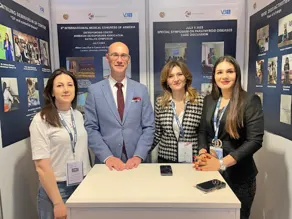
International Osteoporosis Foundation (IOF) in London- April 2024 in the center of this photo are shown Phillip Halbout, Executive Director of the IOF, and Dr. Varta Babalyan, Director of the Osteoporosis Center of Armenia.
World Osteoporosis Day in Yerevan, October 2024 – This event drew over two hundred health care professionals in Yerevan and another two hundred physicians from Tbilisi, Georgia who attended virtually.
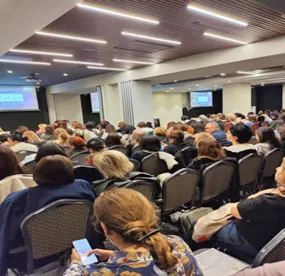
From Yerevan to the World: Showcasing Armenia’s Osteoporosis Center on the Global Stage
Drs. Bilezikian and Babalyan have given lectures throughout the world, with topics that allow us to feature the Osteoporosis Center of Armenia. We have traveled to, or given virtual lectures in; Poland, Italy, Brazil, Slovenia, Slovakia, Romania, Hungary, Austria, Russia, Germany, and locally throughout the United States. Dr. Bilezikian participated in an International Conference of the American Association of Clinical Endocrinologists in Dubai in November 2024.
The Osteoporosis Center of Armenia: Plans and Expectations for 2025
International Osteoporosis Foundation Congress: Rome, Italy, April 10-12, 2025.
The Armenia Osteoporosis Center will participate in this international congress. We will present an abstract of our work that has provided insight into optimal dosing regimens for nutritional supplementation of Vitamin D in Armenian women (see below)
American International Medical Congress (AMIC); July 3-5, 2025.
Already, over 1400 Armenian health care professionals have registered. This International Congress will be held in Madrid, Spain, under the direction of Dr. Lilian Grigorian. The 3-day event will feature how the Armenian Diaspora has contributed to improving health care in Armenia. Serving on the Program Committee of the Congress, I am assisting Dr. Grigorian in plans. Featured at this Congress will be a Plenary Lecture to be given by Dr. Bilezikian as well as a Satellite Symposium that will provide an update on the educational and research accomplishments of the Osteoporosis Center.
Tentative International Medical Conference in the fall in Armenia
We are planning an International Medical Congress in the fall, 2025. Prior to Covid-19, we held this conference annually at which thought leaders throughout Europe would gather in Armenia to share their experiences in education and research as well as become acquainted with Armenia. Over the past several years, I have received numerous requests to activate our program. With sufficient funds, I plan to do this.
Bridging Knowledge and Care: Advancing Osteoporosis Education While Providing Free Screening and Treatment for Underserved Women in Armenia
We continue to provide education to health care professionals and the lay public in regular seminars using the same intimate, integrated format that has proven itself to be so successful. In association with the Armenian Missionary Association of America (AMAA), we are identifying needy Armenian women who do not have the wherewithal to enter into screening programs or afford therapy. We are providing screening with bone density, free of charge, to these women. For those women who need further evaluation and therapy, we are providing that also, free of charge.
In Partnership with Armenia’s Ministry of Health: First-Ever Fracture Liaison Service to Revolutionize Osteoporosis Care and Prevention
For the first time, we will implement a Fracture Liaison Service (FLS) in Armenia. The Fracture Liaison Service (FLS) is a cost-effective, coordinator-based, multidisciplinary model aimed at bridging the care gap between the osteoporotic fracture and recognition of it. Only 25% of osteoporotic fractures lead to evaluation and treatment of the underlying condition. This care gap can be met by a FLS, by ensuring that patients with fragility fractures are first recognized when the event occurs and then receive comprehensive fracture risk assessment and treatment. In doing so, FLS aims to prevent subsequent fractures, thereby reducing morbidity and mortality. In settings where a FLS has been implemented, recognition of the osteoporotic fracture has increased by over 80%. This has led, in turn, to improved long-term treatment adherence, and reduced recurrent fracture events, by 30-40%.
In Armenia, the Minister of Health (MOH) has given written approval of this project, enabling us to identify individuals who have sustained the seminal event. Identified in the hospital, patients will receive comprehensive skeletal evaluations, complimentary densitometry scans, and individualized treatment plans. The FLS coordinator will ensure continuity of care. At follow up visits, laboratory evaluation, bone density, lifestyle modifications, and specific treatment will be implemented.
Research: The Foundation of Better Care
The lynchpin of any successful clinical program is research. To strengthen osteoporosis care in Armenia, we are conducting several research studies, with a primary focus on understanding the country’s unique risk factors and disease burden.
Vitamin D and Iodine Deficiency Under the Microscope
Our current research includes studies on Vitamin D insufficiency, a critical factor in bone health. In addition, we have generated new data on the prevalence of iodine deficiency and thyroid goiter—conditions that also impact skeletal health and are prevalent in Armenia.
A Nationwide Look at Osteoporosis Prevalence
Looking ahead, our research will shift toward a comprehensive epidemiological study to determine how many Armenian women have osteoporosis. This data will be instrumental in shaping future prevention and treatment strategies.
Uncovering Hidden Fractures
One of our goals is to explore how often vertebral fractures go undetected. Globally, it’s estimated that about two-thirds of these fractures are not recognized clinically. We will assess whether this estimate holds true for postmenopausal women in Armenia by analyzing spinal X-rays that may reveal “silent” fractures.
The Role of Bone Density in Fracture Prediction
We will also examine how well bone density measurements (T-scores) correlate with actual fractures. While we know that lower T-scores are associated with increased fracture risk, this study will provide Armenia-specific data on the predictive value of bone density following an initial fracture.
Why Osteopenia Matters More Than You Think
Previous findings, including from our own group, have shown that more osteoporotic fractures occur in people with osteopenic T-scores (a milder form of bone loss) than in those with full-blown osteoporosis. That’s because osteopenia is more common—so even a modest fracture risk translates into a large number of actual fractures.
What We Expect to Find
We anticipate that our data will reveal a monophasic histogram—a peak in fracture incidence within the mid-range of osteopenic T-scores. While those with osteoporosis will remain at the highest individual risk, the greatest number of fractures may actually occur in those with osteopenia, simply due to their greater numbers.
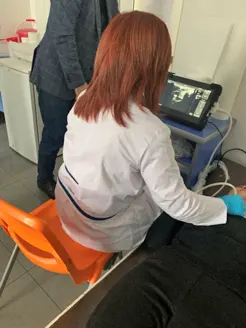
Thyroid disease.
Our work establishing the status of iodine nutrition in the country has led to a key subsequent study that has just been launched. It is designed to understand why a country like Armenia that is no longer iodine deficient, as we have demonstrated, can still have many women with enlarged thyroid glands (goiter). This work is a major aspect of our research agenda for 2024.
This photo was taken on the first day of our project and shows our ultrasonographer using our state-of-art thyroid ultrasound instrument on one of our first study subjects. To date, we have enrolled over 1200 women in the study.
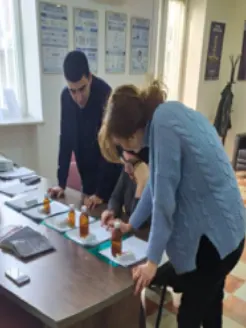
Calcium supplementation in Armenia.
This project is entering its final stages to determine if a new formulation of calcium is more efficacious in building bone. As the only site in the world to be designated for this study, our results will have international impact and call attention to Armenia as a burgeoning site of biomedical skeletal research.
The photo shows distribution of the investigational product to participants in the study. They are discussing the project with one of our research assistants.
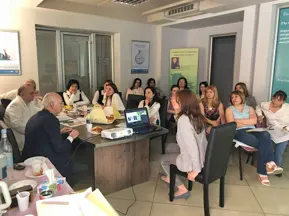
We have on-site physicians on a regular basis. The specialties include endocrinology, rheumatology, gynecology, traumatology, and geriatrics. I am available at any time to provide consultation through our facetime and other virtual links. When I was in Armenia in July 2023, I was able to see patients and lend my own expertise directly to their care.
This photo is an example of me working with the doctors in Armenia at our center.
The Refugees of Artsakh
A consequence of the loss of Artsakh is the displacement of an entire republic. We are providing care to the women of Artsakh at no charge. This new program will have priority this year as we recognize the plight of our people who are now finding their way in a new homeland. We can do a lot by ensuring that their nutrition and skeletal health is optimized by the care that they will receive from our Center.
Budget
The yearly budget for our Center is approximately $400,000. It includes Salaries ($75,000), rent ($11,000), Symposia ($50,000), patient care and education ($ 75,000) and research ($175,000). We are budgeting this year an additional $25,000 to care for the people of Artsakh who will need attention but will not have the means to pay for it. As we describe above, we are committed to providing care for these individuals during the coming year.
Sources of Support
I am profoundly grateful for the support that I have received from The Foundation for Gender-Specific Medicine. I have successfully reached out to other sources of funding such as the JHM Foundation, the Hovnanian Foundation, the Fund for Armenian Relief, the Hologic Corporation, Abiogen, Coral Calcium, Inc., Innova Pharm, the Ministry of Health, and the Vagelos College of Physicians and Surgeons. Support (in kind) has also come from Armenian General Benevolent Union and the Armenian American Missionary Association. What I find inspirational are contributions from grateful patients. In my discussions with them, they have often spontaneously offered to help.
Respectfully Submitted,
John P. Bilezikian, MD, PhD (hon)
